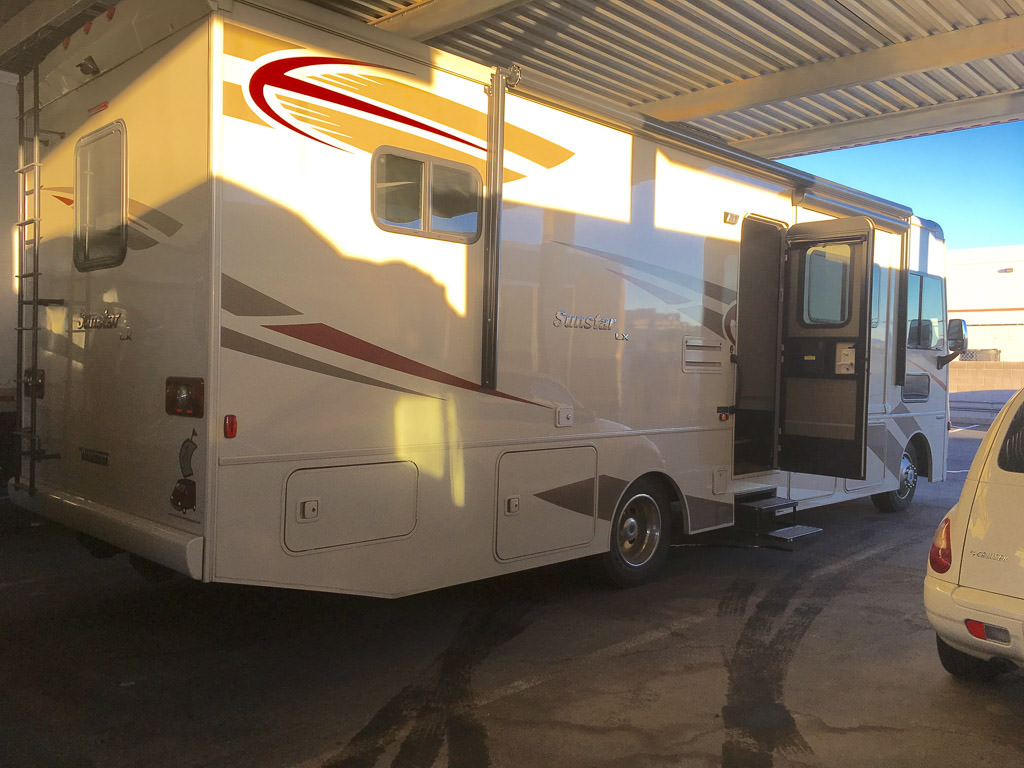
Tips for Storing Your RV
We're east coasters, but we love the West! We drive almost 3,000 miles to get into the mountains of Colorado, the rocks of Utah, and the canyons of Arizona. And in our hearts is our goal of watching those magnificent western sunsets; the sun dropping down as the sky lights up before the carpet of stars appear. Ah, the west!
We commit ourselves to the drive, but then why come home too quickly with the motorhome for some holiday or family time. It's a long drive home and we'd have to deal with weather. This is why, finding RV storage is a solution that has worked well for us.
We find a facility close to a large regional airport where we can store our motorhome for a few months. Then we fly home, taking a break from RV travel. After a month or more, we fly back and remove our motorhome from storage. We usually have an appointment for an oil change, tire pressure check and maybe some minor RV maintenance. Then we make some stops for general merchandise and groceries before getting back on the road to continue our travels. We've avoided the long drive home and the return trip!

Here are some tips to make storing an RV a success:
1. Pick your getaway and storage city.
In determining this, include these factors in your checklist.
- An airport with convenient, frequent, and inexpensive flight availability.
- Storage facilities close to the airport offering great security, and short-term leases (1-3 months). Remember, you'll be storing your RV possessions along with your vehicle.
- Easy transportation from the storage place to the airport. Is there Uber/Lyft availability?
- Plentiful RV maintenance facilities and groceries, for your return to your RV.
- Weather. Since we store for the end-of-the-year holidays, we choose a city with mild temperatures.
For our western travels, we found that Las Vegas is a great place to park our RV with all of our traveling paraphernalia, and we then catch one of the many convenient flights back to the east coast. Storage for our 31-ft motorhome is readily available and secure.
Traveling to the Southeast? Check out Tampa and Orlando as gateway cities. Both offer convenient flights and many RV storage options.
2. Locate a storage facility.
Just search online for "RV storage" and the city you've chosen. There are a number of web sites that can help with the search, including sparefoot.com. We have also found that in many cities, U-Haul offers good storage options. Storage options range from outside to covered to indoor, depending on your needs and budget.
Once you've located some storage options, call (better than using the web) and speak with the facility manager to confirm there is availability. Unless you are willing to pay for excess storage, you usually can't reserve a site more than a month in advance. Also, ask for a discount, as many storage places offer one with a reservation.
We always plan to arrive at our gateway city the day before our departure, so that we have time to physically check out our chosen storage location and complete the required rental paperwork. One time we arrived at our chosen place only to find that the site available would not fit our motorhome. Fortunately, we had the day to secure a site at our second-choice location.

3. Prep your RV for storage.
Now that you've secured your storage site, and reserved your flights, it's time to get your RV prepared for its sleep. Here are some storage tips.
- Drain all tanks; fresh water, gray, and black water.
- If below freezing temperatures are expected during storage, also follow winterization procedures for your rig (drain all water lines, or pump in RV antifreeze).
- If storing outside without being plugged in, shut off all power and make sure to have a way to trickle charge your batteries. We hookup a small 5-watt solar panel for both the coach and starter batteries. These small panels will keep our batteries trickle charged, so that when we return we'll have power. They can be readily found at most RV stores or Amazon. We place the solar panels inside our windshield and add some SAE extension cords so that they can be wired direct to the batteries.
- Remove all food, and clean for crumbs (i.e. in the toaster). Don't leave any tidbits that may entice critters.
- Cover tires and windshield wipers, particularly if your storage location receives bright sunshine.
- Double check that all windows are closed and locked, and double lock the RV entry door.
- Wave goodbye and head to the airport.
When you return, your RV will be there waiting for its next adventure!
Comments
Comments on this post are moderated, so they will not appear instantly. All relevant questions and helpful notes are welcome! If you have a service inquiry or question related to your RV, please reach out to the customer care team directly using the phone numbers or contact form on this page .